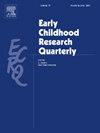幼儿期观察到的养育模式的稳定/变化的预测因素:潜在过渡方法
IF 3.2
1区 教育学
Q1 EDUCATION & EDUCATIONAL RESEARCH
引用次数: 0
摘要
长期以来,亲职教育一直是一个研究课题,因为它对家庭和儿童的发展至关重要。以人为本方法的最新进展表明,通过纵向研究各种养育行为中的养育类型,可以进一步加深我们对养育的理解。因此,本研究旨在考察幼儿期四次年度评估中养育实践模式的潜在转变,并考察基线的个人和家庭水平因素是否能区分养育转变模式。本研究采用了一项随机对照试验中 731 个照顾者-儿童二元组合的四次波次(2、3、4 和 5 岁)的数据。通过潜类分析(LCA)和潜转移分析(LTA),研究了每个年龄段的潜在养育实践类型以及代表连续性和变化的纵向养育实践过渡模式。就 LCA 而言,在所有四个波次中都出现了两个潜在类别,分别代表 "较低的温暖度;较高的负面互动"(失调)和 "较高的温暖度;较低的负面互动"(温暖)育儿群体。在所有波次中都有两个类别的 LTA 模型拟合良好。结果显示,随着时间的推移,过渡模式多种多样,尤其是幼儿期的非线性养育模式。利用多项式逻辑回归法,从 16 种可能的模式中归纳出 6 种过渡模式,并通过儿童性别、家庭收入、主要照顾者的种族、父母参与、儿童抑制控制和儿童外化行为等家庭因素进行预测。研究结果对育儿评估、实践和分析具有重要意义。本文章由计算机程序翻译,如有差异,请以英文原文为准。
Predictors of stability/change in observed parenting patterns across early childhood: A latent transition approach
Parenting has long been a topic of research based on its importance for family and child outcomes. Recent methodological advances in person-centered approaches suggest that our understanding of parenting could be further advanced by examining parenting typologies across various parenting behaviors longitudinally. Accordingly, the current study aims to examine latent transitions in parenting practice patterns across four annual assessments during early childhood and examine whether individual- and family-level factors at baseline discriminate parenting transition patterns. Data from four waves (ages 2, 3, 4, and 5) of a study of 731 caregiver-child dyads from a randomized controlled trial were used. Latent Class Analysis (LCA) and Latent Transition Analysis (LTA) were conducted to investigate underlying types of parenting practices at each age and longitudinal parenting practice transition patterns that represent continuity and change. For the LCA, two latent classes emerged at all four waves, representing ‘lower warmth; higher negative interaction’ (Dysregulated) and ‘higher warmth; lower negative interaction’ (Warm) parenting groups. The LTA model with two classes at all waves was conducted with good fit. The results showed diversity in the transition patterns over time, especially non-linear patterns of parenting across early childhood. Using multinominal logistic regression, six transition patterns, collapsed from 16 possible patterns, were predicted by family factors such as child sex, family income, primary caregivers’ race, parental involvement, child inhibitory control, and child externalizing behaviors. Findings have implications for parenting assessment, practice, and analysis.
求助全文
通过发布文献求助,成功后即可免费获取论文全文。
去求助
来源期刊

Early Childhood Research Quarterly
Multiple-
CiteScore
7.00
自引率
8.10%
发文量
109
期刊介绍:
For over twenty years, Early Childhood Research Quarterly (ECRQ) has influenced the field of early childhood education and development through the publication of empirical research that meets the highest standards of scholarly and practical significance. ECRQ publishes predominantly empirical research (quantitative or qualitative methods) on issues of interest to early childhood development, theory, and educational practice (Birth through 8 years of age). The journal also occasionally publishes practitioner and/or policy perspectives, book reviews, and significant reviews of research. As an applied journal, we are interested in work that has social, policy, and educational relevance and implications and work that strengthens links between research and practice.
 求助内容:
求助内容: 应助结果提醒方式:
应助结果提醒方式:


